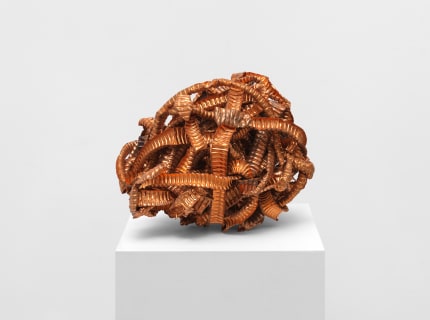Hassan Sharif: Semi-Systems
Alexander Gray Associates presented Hassan Sharif: Semi Systems, the Gallery’s fourth exhibition of work by the artist (b.1951, Iran – d.2016, Dubai, United Arab Emirates). Focused on Sharif’s use of the grid, geometry, and repetitive gesture, the exhibition includes work in a variety of media made as early as 1982 until his death in 2016.
During his studies in London in the early 1980s, Hassan Sharif became exposed to and engaged with conceptual artists, which prompted him to selectively embrace and reject strict tenants of abstraction and automatic form; chance and play. These motifs along with a fascination with mathematical calculations and permutations led him to begin methodical yet absurd performances which he called “Experiments.” On his return to Dubai in 1982, these performances would develop further, taking place for an audience of the camera, in studio urban and desert settings. On view are six documentary images of Drawing Squares on the Floor Using a Cube (1982) in which the artist traced a pre-existing sculptural cube onto the ground in a grid pattern, ultimately creating a larger drawn square that echoes the shape of the traced object.
Concurrently, Sharif applied the same approach of repetition and variation to a series of geometric and linear drawings, the “Semi-Systems,” which he would continue throughout his career. Conceived with arbitrary mathematical rules or instructions that were often outlined in accompanying workbooks, the artist would embrace rebellions within these frameworks, breaking rules, inverting formulas. While making this work in Dubai, Sharif was witnessing changes in religious practice, the transformative impact of the UAE’s political independence, and rapid economic growth and speculation. As art historian Paulina Kolczynska writes, Sharif “wanted to remain at the fringes of the system in order to retain space for the creation of his own constructivist process… it was through his coined description of “semi-systems” that he made an important statement, signaling that he was taking some distance from the original systematic agenda.”
Central to the exhibition is the monumental wall painting Clockwise. The painting structure is derived from a 2008 diptych of the same title, each panel of which includes a columnar grid formation, with one line emphasized in each cube. While these works rely on straightforward geometry, they are hand drawn and imperfect. Also on view are Sharif’s preparatory drawings, or ‘draft papers’ which illustrate how his formulations were mutable and could yield an array of results. Similarly imperfect is the wall-based object Springs (2016), which is comprised of coiled metal draped from the wall, each tendril ending at a different length, some coils more taut than others. The springs themselves are a feat of mathematical engineering. Sharif capitalizes on their existing structure and arranges them on the wall, much in the way he used the generic lines, squares, and dots in endless orientations. In total, the range of works on view reflect Sharif’s humor and flexibility that was the source and result of his lifelong artistic practice. As the artist explained, “Sometimes I make some mistakes in my works, I keep them as they are without correction because I believe that ‘Art’ is a result of errors.”


